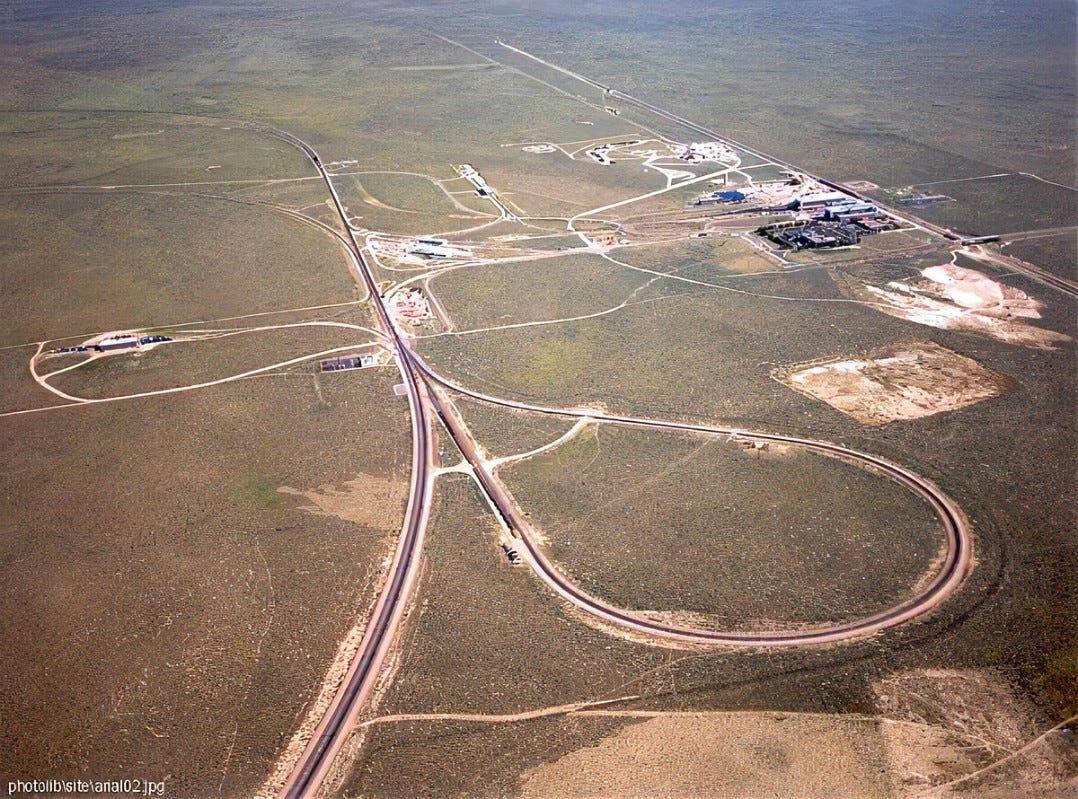Not One, but Two! Guest Post by X-1
To my everlasting consternation, now there are two rail research facilities in the U.S., and side by side no less.
To my everlasting consternation (see Trains Magazine AAR’s research and testing subsidiary renamed MvX Rail), now there are two rail research facilities in the U.S., and side by side no less. I suppose I could call this “How the Worm Turns.” Anyway, here’s a brief recap of the Test Center and how we got to this point:
LBJ’s High Speed Ground Transportation Act of 1965 was enacted as this country’s first attempt to foster the growth of high speed rail (how prophetic), as a result of the success of Japan’s “bullet train,“ the Shinkansen.
This was all part of LBJ’s Great Society infrastructure building initiatives (sound familiar?). The bill also created the Office of High Speed Ground Transportation within the Department of Commerce (two years later it was moved over to the newly created Department of Transportation). It also spawned the Metroliner project in the Northeast Corridor (they started running on January 16, 1969).
Last but not least, it created the High Speed Ground Test Center in Pueblo in 1971. They began testing three futuristic high speed ground vehicles, namely the Linear Induction Motor Research Vehicle, the Prototype Tracked Air Cushion Vehicle, and the Tracked Levitated Research Vehicle. (Elon Musk, eat your heart out.)
The railroads were experiencing a lot of derailments in the early 1970s, due largely to deferred maintenance. With only marginal interest in the three sophisticated high speed ground vehicles the Department of Transportation (DOT) was testing, with the success of the Metroliner project, and with the growing railroad problems, it was decided to shift the focus to more conventional railroad testing and the facility name was changed to the Transportation Test Center (TTC) in 1974, and the Federal Railroad Administration was designated to manage it.
When I arrived at the TTC in 1977, we were just wrapping up the last of the three high speed vehicles, the Linear Induction Motor Research Vehicle (LIMRV). It’s claim to fame was that it achieved a world speed record (at the time) of flanged wheel on steel rail of 255 mph (the vehicle was operated remotely during the test).
After many, many successful conventional railroad tests, both passenger and freight, conducted over the period (1975-1982), and all results shared freely and openly with the world, by 1982, the Reagan Administration had decided to get the government out of the railroad business. It had four specific goals.
Goal #1 was to privatize the TTC, and thus it was turned over to the Association of American Railroads (AAR) that same year (1982). I left at that time.
[Goal #2 was to unload the Alaska RR on the state, which was achieved in 1985; Goal #3 was to privatize Conrail, which was accomplished in 1987; Goal #4 was to privatize Amtrak, which, as of today, 40 years later, has not yet been achieved.]
While the DOT still owned the TTC, over the years, it lost interest and involvement in it, and the AAR renamed it the Transportation Technology Center, Inc. Since 1982, all research and testing has been conducted on a strictly proprietary basis, and continued as such over the ensuing years.
Out of nowhere, in 2021, the Biden Administration, committed, through the DOT, $580 million to the TTC to reclaim full operation and designated ENSCO to operate and maintain it, starting this fall. Now it appears the government is back in the railroad business, at least the research end.
That left the AAR to their own devices, and they had to move out, which they are in the process of doing, by relocating a few miles west to a new facility that they are building by the airport to continue their railroad research, to be called M x V. (I notice that Trains Magazine got the initials mixed up.)
Epilogue: it will be interesting to see if there is enough business for two rail research facilities, one private and one public, and located next door to each other, where outside testing can be observed. Will they complement each other, or work at cross purposes?
X-1, Alumnus, TTC
Cogent publisher, Frederick R. Smith






Who puts in the useless Trollies, and decides a bus route is not profitable? Memphis put in a short distance 1 first, electric, few passengers, meant to reduce traffic, it was a failure at that, 50 cents a trip didn't begin to pay the operator, it tried to look old fasion, but didn't quite get the look right. Drew a few out of town visitors. Then they decided to put in a longer sytem in the medical district, road was unusable for a year, I doubt it ever turned a profit both still operate. Many buildings had parking garages or 1 nearby. Buses use to be fairly safe to ride for downtown dwellers, not any more, most routes don't get you close enough, are money losers due to the Unsavory passengers. They even had 1 of the big bus' come clear out to the Navy base 30 + miles, if it had 4-5 passengers was doubtful. Even when it was a Training base, instead of the Record keeping base it now is, and much smaller. As most personel either had cars or carpooled to go to the better class bars, or take dates on. Time to downsize or cease to operate.